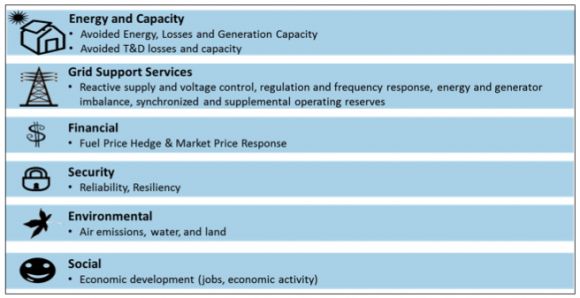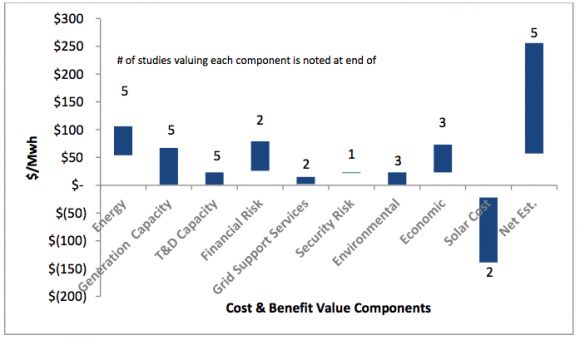The ability to accurately calculate the value of solar can be a useful tool for helping to integrate increasing amounts of distributed solar PV onto the grid. It’s also a critical tool that can help utilities, regulators and stakeholders make rational planning decisions and design effective incentives as they integrate distributed energy with the century-old power grid.
Determining the value of solar (VOS), however, is a tricky proposition. Factors such as the social benefits of renewable energy and the long-term value of avoided greenhouse gas emissions are difficult to quantify. There are also questions of equitability that need to be addressed related to who benefits from distributed solar and how solar is treated relative to conventional generation projects.
The methodologies currently used for evaluating the costs and benefits of distributed solar are all over the map. According to a new report from ICF International, “Utilities, investors, and markets are missing out on optimal strategies to price assets, lower costs, and mitigate risks, because they lack a consistent and accurate approach for determining the true value of solar.”
It will become increasingly important to find a consistent method for calculating the value of solar as solar becomes a larger part of the energy generation mix, according to the authors. In the period between mid-2012 to mid-2014, cumulative solar PV installations in both the residential and non-residential domains both doubled. GTM Research predicts that distributed solar installations on commercial and residential premises will grow from 1.9 gigawatts in 2013 to 5.8 gigawatts by 2018.
There have been numerous attempts to get a grip on methods for calculating the true value of solar. The Rocky Mountain Institute released a benchmark report last year synthesizing the findings from fifteen existing VOS studies. The studies generally agreed on a broad set of cost and benefit categories.
But despite these efforts, no institution or agency has yet developed a holistic methodology, according to ICF.
FIGURE 1: Typical Solar PV Benefit and Cost Categories

Source: ICF International
ICF reviewed five public VOS studies included in the RMI report and found that they were lacking in terms of consistency, transparency, and a number of key value and cost components. The studies varied widely in their VOS estimates, ranging from $50 per megawatt-hour to more than $250 per megawatt-hour. They were also inconsistent in their benefit and cost estimates by category.
In the majority of the recent VOS studies that ICF analyzed, benefits manifested as avoided energy and capacity purchases, as well as avoided transmission and distribution impacts. However, categories such as financial risk, grid support services and security issues were valued in some studies but not in others.
FIGURE 2: Range of VOS Cost and Benefit Price Estimates

Source: ICF International
“Many studies continue to tend to value distributed solar generation as a load reduction measure as opposed to a system resource,” said Steve Fine, vice president of ICF International and co-author of the report. “In the various studies conducted, the value of solar is often compartmentalized into similar categories, but the methodologies regarding how the values are calculated are inconsistent.”
ICF laid out nine methodological recommendations for accurately determining VOS:
- Energy: Avoided energy generation from the grid is the most straightforward calculation, and it should be quantified at the margin.
- Avoided/deferred generation capacity: This should be a realistic analysis of the correlation between customer and system peak, and of distributed solar system’s generation profile to accurately assign capacity credit.
- Avoided T&D losses and capacity: A separate analysis of the benefits and costs of distributed solar on the T&D portion of the grid should be undertaken, with careful consideration of distributed PV that will be deployed and loads currently being served.
- Grid support services: This should not be included in a VOS calculation for potential payment, but it should be reviewed to determine potential value when the appropriate technology exists.
- Environmental: Distributed solar should be evaluated the same way as any new power generation resource, with values assigned on a dollar-per-ton basis.
- Financial: Factors such as fuel price hedge, reservation of natural gas pipeline capacity, and/or market prices response, which are not typically accounted for by utilities, should not be included in a VOS analysis.
- Social: Construction of utility-scale conventional and renewable projects do not include social values and so should not be a part of VOS analyses.
- Security: PV systems that can isolate from the grid can offer reliability to the owner. However, this value does not accrue to the larger grid, and so security benefits should not be included in the VOS calculation.
- Frequency to update VOS: The utility should update the value-of-solar tariff for new installations on an annual basis to account for changes in solar capacity and energy use.
These recommendations are meant to offer a common framework for analysis, rather than a specific VOS calculation. Calculating the value of these categories would require an analysis tailored to the particular circumstances of a utility’s geography, energy market and physical grid infrastructure.
“We are not advocating for ‘a’ value of solar, which will differ due to the location and system specifics, but do think a consistent, common framework of analysis is required,” said Fine.
Minnesota is the first state in the nation to tackle the VOS issue. Last year, the state passed legislation requiring the Department of Commerce to establish a VOS methodology that must include the “value of energy and its delivery, generation capacity, transmission capacity, transmission and distribution line losses and environmental value.”
The law allows investor-owned utilities to apply to the public utility commission for a VOS tariff as an alternative to net energy metering. In April, Commerce submitted its final VOS methodology to the PUC for review.
Other states looking to maximize the benefits of solar will soon have to embark on the same project. First, regulators, utilities and other stakeholders will have to agree on a set of cost-benefit considerations for solar, like the one proposed ICF. And if they get that far, they’ll be rewarded with the arduous task of assigning specific values to each category.



